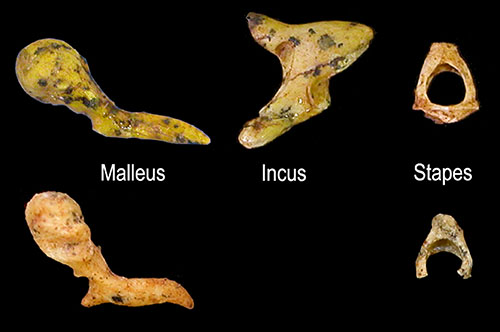Ear Fossil
Oldest fossil hominin ear bones ever recovered: Discovery could yield important clues on human origins Science Daily - May 13, 2013

Anthropologists could shed new light on the earliest existence of humans. The study analyzed the tiny ear bones, the malleus, incus and stapes, from two species of early human ancestor in South Africa. The study analyzed the tiny ear bones, the malleus, incus and stapes, from two species of early human ancestor in South Africa. The ear ossicles are the smallest bones in the human body and are among the rarest of human fossils recovered. Unlike other bones of the skeleton, the ossicles are already fully formed and adult-sized at birth. This indicates that their size and shape is under very strong genetic control and, despite their small size, they hold a wealth of evolutionary information.
Fossil shows traces of first modern ears NBC - September 11, 2007
A 260-million-year-old fossil of the small reptile Bashkyroleter mesensis shows traces of the first known modern ear. The drawing at bottom highlights a reconstruction of the extremely large eardrum structure. The entire skull is about 2.5 inches (6.5 centimeters) long. The first backboned creatures to conquer land were largely deaf, lacking anatomical features whereby tiny bones help transmit airborne sounds into the inner ear. Advanced hearing was assumed to have evolved shortly before the emergence of dinosaurs, roughly 200 million years ago. Now, scientists have found that weasel-sized prehistoric reptiles from Russia apparently possessed the first modern ears 260 million years ago - perhaps the first-known specialized trait for living in the dark. Paleobiologists uncovered large-eyed fossils of these reptiles with surprisingly advanced ears near the Mezen River in central Russia. They are a kind of now-extinct reptile called a parareptile.
The first backboned creatures to conquer land were largely deaf, lacking anatomical features whereby tiny bones help transmit airborne sounds into the inner ear. Advanced hearing was assumed to have evolved shortly before the emergence of dinosaurs, roughly 200 million years ago. Now, scientists have found that weasel-sized prehistoric reptiles from Russia apparently possessed the first modern ears 260 million years ago - perhaps the first-known specialized trait for living in the dark. Paleobiologists uncovered large-eyed fossils of these reptiles with surprisingly advanced ears near the Mezen River in central Russia. They are a kind of now-extinct reptile called a parareptile.
These findings suggest early terrestrial animals and ecosystems were not as primitive as once assumed. "Although efficient hearing abilities and a nocturnal lifestyle seem to be nothing unusual in our modern world, they might have had revolutionary effects at this early time," Mueller told LiveScience. These reptiles are part of a completely extinct lineage distantly related to turtles, lizards, snakes, crocodiles, birds and dinosaurs. The advanced ears we see today are thought to have evolved mostly independently of each other, Mueller explained. "It would be interesting to investigate how often and when exactly modern ears evolved. For example, do the ears of modern lizards, crocodiles and birds have a common origin or not?" Mueller said.

Hearing
PALEONTOLOGY INDEX
ANCIENT AND LOST CIVILIZATIONS
PHYSICAL SCIENCES INDEX
ALPHABETICAL INDEX
CRYSTALINKS HOME PAGE
PSYCHIC READING WITH ELLIE
BOOK: THE ALCHEMY OF TIME
DONATION TO CRYSTALINKS
ADVERTISE ON CRYSTALINKS

